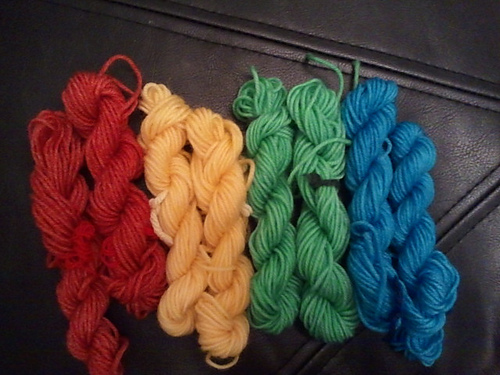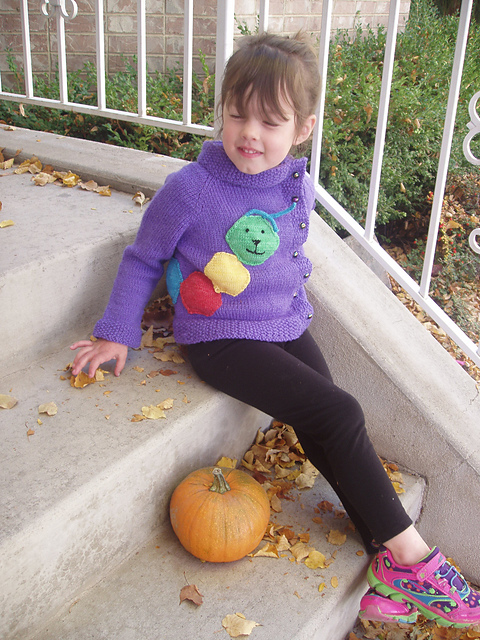One night, my husband came home and found the kitchen in disarray. "What's all this?" he asked.
"
I'M DYYYYYYYEING," I wailed.
And I was. Dyeing with an E, that is!
It's really easy to dye yarn made from animal fibers (wool, alpaca, cashmere, even silk) and nylon, and you can use common ingredients you probably already have in your kitchen!
My first dyeing experiments were for a
colorwork sweater for my oldest daughter. First, I wanted to make sure we liked the colors, so I did little samples of 20" of yarn. I was trying to do about 1% of what I'd use for the final dye concentration, so I filled up my containers with 100 mL of water, added the dyes (food coloring and Kool-aid), and then used a dropper to get 1 mL of the dye stock. I mixed that 1% dye stock with more water.
Here's a secret of dyeing:
it doesn't matter how much water you use. I measured the water to get the concentration right for a tiny test, but when you do the actual dyeing, as long as you have enough water to cover your yarn and let it circulate,
the only proportion you really need to worry about is the amount of dye to the amount of yarn (by weight).
To
prepare the yarn, you need to wind it in hanks (long loops) and tie figure-eight ties through the loops in three to four places to prevent tangling. Then soak it in clean water. (You'll need vinegar later, so you can add it to the soak water instead of the dye bath, but I usually don't.)
Then you can
prepare the dye stocks. Tools of the trade: tons of measuring cups to get my 1% solutions, microwave safe containers and a kitchen scale.
The colors in my rainbow here are McCormick's neon pink food coloring, McCormick's yellow food coloring, McCormick's green food coloring, Ice Blue Raspberry Kool-aid, and a mix of McCormick's neon purple (2 parts) and neon blue (1 part).
In the foreground, I'm soaking the yarn samples to be dyed.
Now it's time to dye! You need heat and acid to set this dye on protein fibers. With food coloring, you have to add some vinegar; a tablespoon in the dye stock is plenty (this doesn't have to be measured either! No wonder I love this!). The Kool-aid doesn't need vinegar because it already has citric acid. The heat is simple too: microwave! (Stovetop and oven work just as well too--but don't boil the yarn; it felts.)
Above, my tests are ready to microwave: I put 1mL of the dye stock into a baggie, added more water, and put in my wet yarn. I did more of the blue because I had a few samples of other things I was thinking about dyeing.
I nuked them for 2 minutes, let them sit for 10 and nuked them for 2 minutes. I repeated this until the dye bath "exhausted," meaning the water was clear (or milky in the case of the Kool-aid, but the dye was absorbed by the yarn). Here they are after microwaving:
Baggies may not be the best choice for this... But notice how the yarn is colorful and the water, not so much.
My daughter and I picked the colors for her sweater from the samples and then I stuck the yarn to be dyed in the full dye baths:
And, below, after microwaving. Check out the water--it's clear, except in the purple. Blue dyes often take longer to exhaust, so I recommend leaving the yarn in overnight after heating:
This jar of yellow did something interesting. Maybe I didn't have enough acid in it, but while it was in a cool-down phase between microwave bouts, I was worried about how much dye was left in the water. I added more vinegar and turned around to put away my big ol' jug. By the time I looked back, the water was perfectly clear and the yarn a vibrant yellow!
Allow the yarn to cool--you can speed this up by taking it out of the dye bath, but
DO NOT PUT COLD WATER ON HOT YARN. This will cause the yarn to felt.
Once it's cool, you'll want to
rinse the yarn with clean water. Be sure the rinse water runs clear. If it doesn't, either your dye isn't set, and you need more acid and/or heat, or you've used more dye than the yarn can actually absorb, so the excess is washing off. The yarn will usually fade more dramatically if the problem is that the dye isn't set.
And now it's time to
dry! Above, the yarn is hanging out in my salad spinner, which is really handy for drying small amount of yarn. Below, it's hanging on a chair with a fan to dry the rest of the way.
Since this was for colorwork, I made myself some posterboard bobbins and wound up the yarn. The darker pink and the white are purchased--
Knit Picks Wool of the Andes Sport in Rouge and White--and the white is the base for the other colors.
And in the finished product:























